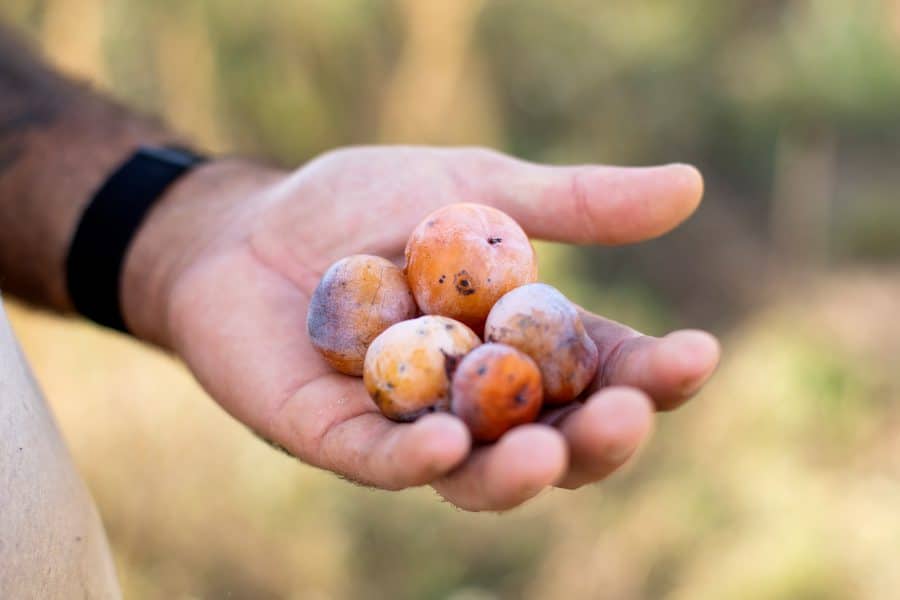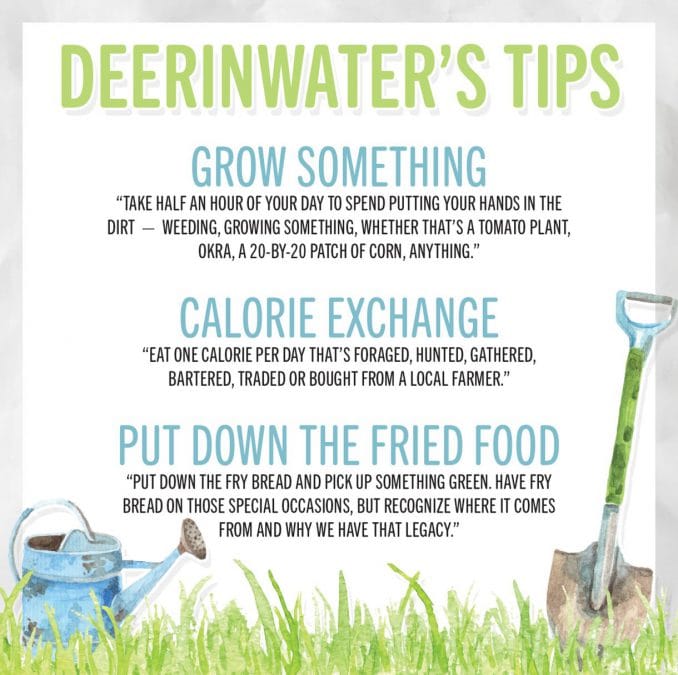Food often serves as the center of every culture. However, since colonization, Indigenous food systems have been stripped from Indigenous people across the world. In America, federal policies removed many Native Americans from their lands, which in turn, caused them to lose connections to the plants and animals that sustained Indigenous people since time immemorial. This disconnect influences overall health and wellness, which manifests as mental illnesses, diabetes and other negative health-related outcomes.

“There is also a lot of healing that can be done with changing those food habits. Food policy is definitely there to break the connection and the relationship we have with the land. And we can see the consequences of that in our health,” said Kaya DeerInWater, Bodewadmi Widoktadwen Gtegan (Citizen Potawatomi Nation Community Garden) assistant.
Incorporating Indigenous agricultural systems into food policy can address public health issues while simultaneously healing Native Americans physically, emotionally and spiritually.
Sacredness
Colonization profoundly affects Native America’s sense of community. Harvests were only done by hand and often served as social gatherings.
“People enjoyed each other and still enjoy doing it,” DeerInWater said. “It’s about this bigger aspect, which is just about connecting with the land, connecting with Creator and Mother Earth, Father Sky, all of those things, and recognizing the spirit in everything. It’s more integrated than a lot of Western concepts of spirituality. We are not separate from nature. We are nature.”
Since Europeans arrived in North America, policy governing Native peoples encouraged removing Native Americans from their ancestral lands, which in turn removed communities from their traditional foods and diets.
“Ultimately, without that, we are no longer connected to our lands and our life, our livelihoods, and our culture,” he said. “You can’t have culture if you don’t have lands, and when your culture and your language is connected to your lands, everything starts to unravel.”
Many across Indian Country seek to end this disconnect by incorporating traditional foods into their diets.
“Pre-contact food is food that, like the name says, existed prior to Europeans arrival in the Americas, so that would have been around 1491,” DeerInWater explained.
However, more than just Native Americans need to de-colonize their diets, “and it’s not just Native peoples who are searching for more connection and more relationships with the land around them,” he added.
Opportunities exist daily for all people to build connections to earth and return to a more sustainable way of living.
“And a way that will make room for future generations because right now, we consume way more than our current generation is allotted,” DeerInWater said. “We’re eating into our future generations’ budgets, so to speak.
“That is what’s most concerning. What are we leaving our kids?”

Peak of freshness
One way to adhere to pre-contact traditions is to eat seasonally, which also increases the nutritional bioavailability of food.
“Like with berries being ripe in the summer,” DeerInWater explained. “Typically, you’re moving around, you do a lot of activities in the summer when it’s warm, and having a lot of sugar in your diet isn’t so bad because you’re always moving around. But eating the berries during the winter when you’re just sitting around watching movies, beading, whatever you’re doing — there’s a difference.”
Many of the 13 moons recognize when specific foods reach their peak of freshness. For example, August is Minkegises (Berry Picking Moon) and September is Mnomnekégises (Ricing Moon).
“All of those things are so important culturally that a whole time frame is devoted to them, and our ancestors looked forward to that time and devoted a lot of effort and energy and intention into them, making sure each of those happened, not only because it was important to them, but it was also a necessity,” DeerInWater said.
For those who have an opportunity to strategically spend their grocery budgets, consumer dollars can have an impact on markets. Making conscious decisions to purchase only what is in season can help create changes across Turtle Island and the world.
“You can easily find a seasonal food calendar online, and you don’t have to get super crazy about it. You know, just maybe don’t buy strawberries in January or don’t buy apples in June,” DeerInWater said.
Out-of-season produce must travel thousands of miles to reach grocery stores, and overseas products often are flash-frozen.
“We’re talking about it as if people have a choice, and there are a lot of people who don’t have a choice, and we have to acknowledge that,” he explained. “I think we need to work on getting those folks into a better place, but that doesn’t mean we can’t also work on ourselves and work on the people who already have those choices.”
Holdbacks
“There is a difference between survival and thriving, and right now, a lot of folks I feel like are caught in that survival mode,” DeerInWater said.
Also, because so many communities have not had those connections to traditional fare, it can be harder for individuals to have an open mind and open taste pallet.
“People are so accustomed to commodity foods that they become acclimated to that and resistant to Native, pre-contact foods, or traditional ancestral foods,” DeerInWater said. “I myself eat fry bread, but making that your daily thing is probably not the wisest health choice.”
Minimizing consumption of processed food decreases sugar intake. One easy transition is exchanging soda for water.
“That’s a shift that could help you in the long run, or all the way scaled up to buying a head of broccoli instead of buying a pound of meat. That kind of thing can also help your health as well as the food system,” he said.
While changing to an all pre-contact foods diet may be impossible for everyone, DeerInWater encourages exchanging one non-traditional food for its traditional counterpart.
Pantry switches
One easy switch includes opting for sunflower oil that withstands high temperatures instead of canola, corn and even olive oil.
“Sunflower is one of our Four Sisters crops,” DeerInWater said. “So, in a way, it’s cultural.”
Organic produce requires less chemicals to grow and can have up to 15 percent more nutritional value over its non-organic counterparts, according to DeerInWater.
“Organisms aren’t really just solely organisms,” DeerInWater said. “Just like food is processed by gut bacteria we have, our plants and other animals are similar. So when you’re spraying herbicide all over your plants to kill some bugs, you’re also killing all the bacteria associated with that plant.”
Bacteria work with plants and trees to help process sugars and assist with nutrient uptake.
“I try to tell people, just consume one calorie a day that is either foraged, bartered or grown locally and/or hunted locally that you know exactly where it came from and when,” he said. “Even that little act of intention of reconnecting with our ancestral foods and our land and our community is really what it’s going to take to make the next step. It doesn’t happen for me every day, but I think about it every day. And it’s going to take us all thinking about it more to make a difference.”
